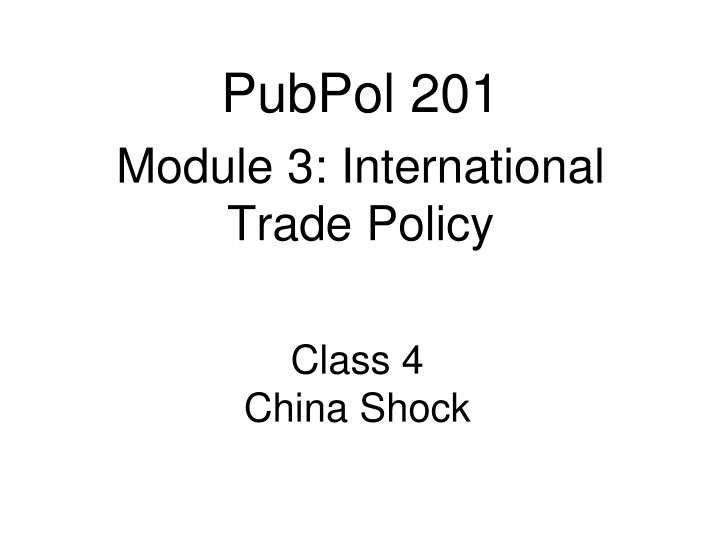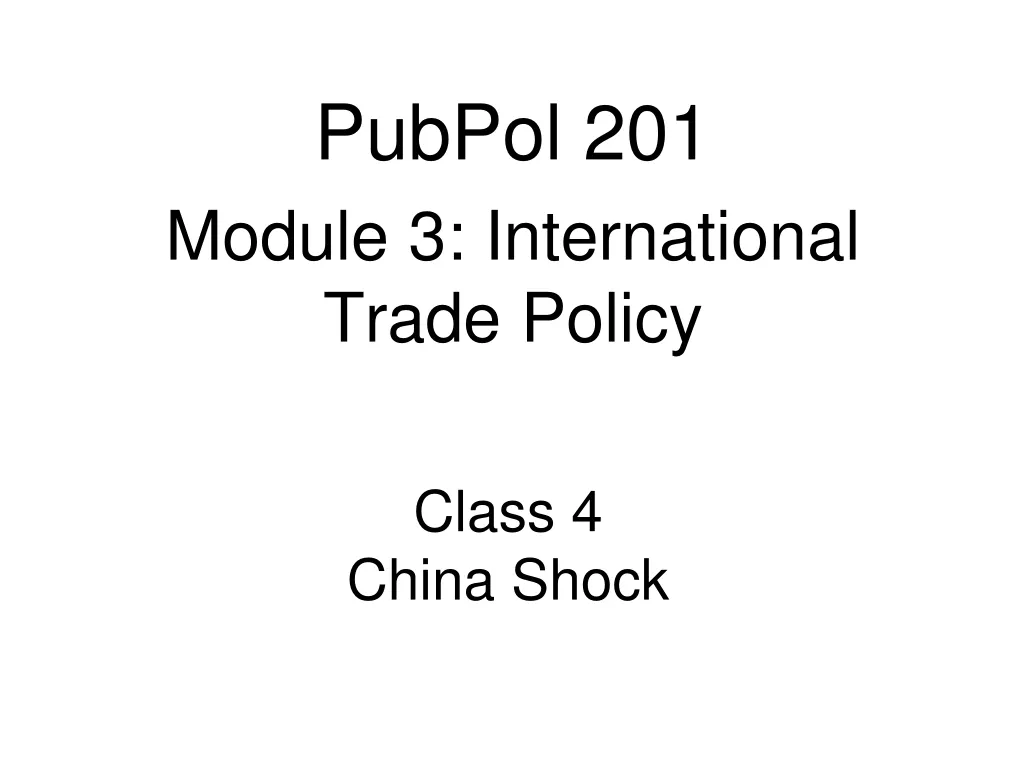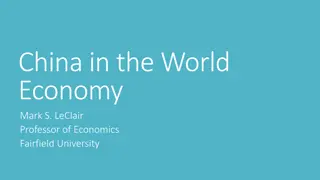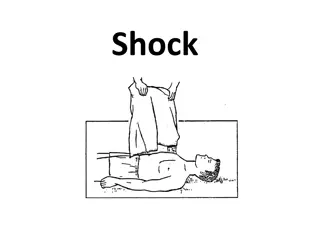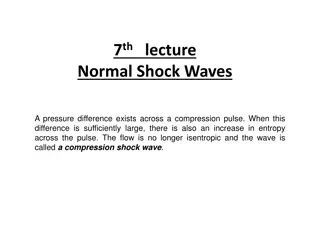China Shock and Its Effects on US Economy
Explore the impact of the China Shock on the US economy due to China's rapid export growth after opening its markets in the 1980s. Analyze implications, GDP growth rates, and China's WTO entry in this insightful class on international trade policy.
Download Presentation

Please find below an Image/Link to download the presentation.
The content on the website is provided AS IS for your information and personal use only. It may not be sold, licensed, or shared on other websites without obtaining consent from the author.If you encounter any issues during the download, it is possible that the publisher has removed the file from their server.
You are allowed to download the files provided on this website for personal or commercial use, subject to the condition that they are used lawfully. All files are the property of their respective owners.
The content on the website is provided AS IS for your information and personal use only. It may not be sold, licensed, or shared on other websites without obtaining consent from the author.
E N D
Presentation Transcript
PubPol 201 Module 3: International Trade Policy Class 4 China Shock
China Shock What is (was) the China Shock? The very rapid growth of China s exports to world markets After they opened their markets in the 1980s And especially after they joined with WTO in 2001 This had large effects on the US, which we will study Lecture 4: China 2
China Shock Why study the China Shock? It s usually hard to study the effects of trade empirically, because so much else happens. The China shock was big enough and special enough to isolate its effects Implications matter for more than just trade with China Lecture 4: China 3
Class 4 Outline China Shock China s growth The China Shock The ADH analysis Other sources Lecture 4: China 4
Class 4 Outline China Shock China s growth The China Shock The ADH analysis Other sources Lecture 4: China 5
Chinas Growth Was China s growth expected? Not by the Wall Street Journal, June 23, 1989 Expected growth leaders: Bangladesh, Thailand, and Zimbabwe Expected laggard: China Due to the stultifying bureaucracy of hard-line communism Lecture 4: China 6
GDP Growth Rates Source: World Bank Lecture 4: China 7
GDP per capita (Constant 2000$) Source: World Bank Lecture 4: China 8
GDP Growth Rates Source: World Bank Lecture 4: China 9
GDP per capita (Constant 2000$) Source: World Bank Lecture 4: China 10
Chinas WTO Entry Lecture 4: China 11
Clicker Question Imports from China accelerated after it entered the WTO in 2001. When did employment in US manufacturing begin to decline? a) 1945 b) 1980 c) 2001 d) 2008 Lecture 4: China 12
Clicker Question In the most recent data reported here, which country s GDP is growing fastest? a) China b) India c) Japan d) South Korea e) United States Lecture 4: China 13
Chinas Growth Why China s export growth accelerated after joining WTO in 2001 Not because others reduced tariffs on Chinese exports. They didn t. Instead they required China itself to lower tariffs and make other changes Lecture 4: China 14
Chinas Growth Why China s export growth accelerated after joining WTO in 2001 Privatization of some former SOEs (state-owned enterprises) made them more efficient. Phased out restrictions that had inhibited exports. Lower Chinese tariffs gave industries cheaper imported inputs, making them more productive. Reduced uncertainty about foreign tariffs, unblocking investment. US applied WTO (MFN) tariffs to China s exports But each year US debated whether to continue Lecture 4: China 15
Class 4 Outline China Shock China s growth The China Shock The ADH analysis Other sources Lecture 4: China 16
China Shock Why study the China Shock? It s important for its own sake Many think it is the cause of the large decline in US manufacturing But look at the data That decline started long before the China Shock Lecture 4: China 17
China Shock Why study the China Shock? Also, it s usually hard to find evidence of how trade affects an economy Changes in trade are usually Accompanied by many other changes Caused in part by the economies you want to study Thus causation is hard to figure out But the China Shock was plausibly a natural experiment A change in the real world similar to a controlled experiment Lecture 4: China 19
China Shock Why study the China Shock? Whay was the China Shock plausibly a natural experiment China s growth, and the growth of its trade, were unexpected Its cause was largely the extreme isolation of China under Mao Its comparative advantage was distinctive: much of manufacturing but not primary products or resources Lecture 4: China 20
China Shock Why study the China Shock? So the China Shock can give us information about how other changes in trade, including smaller ones, may affect an economy like the US Lecture 4: China 21
Chinas WTO Entry Lecture 4: China 22
Chinas WTO Entry Revealed comparative advantage uses a formula to try to infer a country s comparative advantage from data on its, and the world s, trade. Lecture 4: China 23
China Shock Nature of the China Shock China s growth of exports to the US was broad Covering most of manufacturing Greatest in most labor-intensive sectors Varied in size across products within an industry The variation suggests that effects will differ across localities in US, which specialize in different products So the natural experiment differs across localities, giving multiple observations to study Lecture 4: China 24
Measure of labor intensity Lecture 4: China 25
Clicker Question Why do economists sometimes use natural experiments ? a) Natural experiments do not require funding b) To avoid being accused of actions that are unnatural c) Because they cannot themselves control economic conditions d) Natural experiments are welcomed because they are beneficial to their subjects Lecture 4: China 26
Discussion Question The data show clearly that US imports from China rose at the same time that US manufacturing fell. Why is that, by itself, NOT enough to tell us that imports were harmful to the US? Lecture 4: China 27
Class 4 Outline China Shock China s growth The China Shock The ADH analysis Other sources Lecture 4: China 28
The ADH Analysis The data show Simultaneous growth in China s current account surplus US s current account deficit Lecture 4: China 29
Chinas WTO Entry Lecture 4: China 30
The ADH Analysis The data show Simultaneous growth in China s current account surplus US s current account deficit That over the whole period 1991-2011, as well as sub-periods, across industries Imports from China grew Employment fell Lecture 4: China 31
? = change Log ? = change in the logarithm percent change SD = standard deviation (measure of how different observations are) Lecture 4: China 32
The ADH Analysis The data also show (from the standard deviations) That there was considerable variation across industries in both import penetration and employment loss This indicates that the data may reveal the relationship between them Lecture 4: China 33
The ADH Analysis And they show that employment declined more in the later years: 0.3 log points ( percentage) 1991-1999 3.6 log points 1999-2007 5.7 log point 2007-2011 Lecture 4: China 34
The ADH Analysis Regression analysis ADH used standard statistical techniques to estimate the relationship between the two variables. Lecture 4: China 36
The ADH Analysis Regression analysis ADH used standard statistical techniques to estimate the relationship between the two variables. Table 3 shows results for manufacturing only Col 1: OLS = Ordinary Least Squares Cols 2-3: 2SLS = Two-Stage Least Squares Lecture 4: China 37
Estimated change in employment associated with a 1-percentage point rise in import penetration Dummy variables for time periods: Ignore Thus highly statistically significant Three stars mean probability that true effect is zero is less than 1%. Lecture 4: China 38
The ADH Analysis Why 2SLS? OLS results could be biased because growth in import penetration is driven partly by domestic shocks. Correlation is not causation 2SLS avoids this bias by using instrumental variables Here these are import penetration from China in countries other than the US Lecture 4: China 39
The ADH Analysis Regression analysis ADH used standard statistical techniques to estimate the relationship between the two variables. Table 3 shows results for manufacturing only Col 1: OLS = Ordinary Least Squares Cols 2-3: 2SLS = Two-Stage Least Squares These estimates can be used to plot maps of how parts of the US have been affected Lecture 4: China 40
This map mainly just shows where manufacturing is, and isn t Next map controls for this Lecture 4: China 41
This map captures, for whatever manufacturing there is in a place, the extent to which it competes with imports from China Lecture 4: China 42
Clicker Question Why is SE Michigan a lighter shade in the second map than the first? a) The second shows that population has moved away from Michigan b) The auto sector was not impacted by imports from China c) Michigan does most of its trade with Canada d) More manufacturing is concentrated here than in much of the country Lecture 4: China 43
The ADH Analysis Effects on other things Table 4A shows that import penetration causes Fall in employment in non-manufacturing Rise in unemployment Rise in not in labor force Table 4B shows that it also causes Fall in population Fall in wage Rise in transfers (from government) Lecture 4: China 44
Discussion Question Why would the China Shock cause each of these effects in localities with increased imports? Fall in employment in non-manufacturing Rise in unemployment Rise in not in labor force Fall in population Fall in wage Rise in transfers (from government) Lecture 4: China 46
Note how small is the contribution of Trade Adjustment Assistance Lecture 4: China 47
The ADH Analysis Persistence Another finding of ADH (I won t show the graph) is that displaced workers tend either to remain in their same trade-impacted industry or move to another that is also vulnerable. Labor-market adjustment to trade shocks is stunningly slow Lecture 4: China 48
The ADH Analysis The China Shock: ADH Concluding Comments Employment has certainly fallen in U.S. industries more exposed to import competition. so too has overall employment in the local labor markets in which these industries were concentrated Offsetting employment gains have, for the most part, failed to materialize. I question this, though, since US unemployment is so low But: The great China trade experiment may soon be over, if it is not already. Lecture 4: China 49
Clicker Question Why do ADH suggest that the China Shock may soon be over, if it is not already ? a) Wages are rising in China b) President Trump is discouraging imports from China and may raise tariffs c) US manufacturing is so low, it cannot fall any further d) It will be replaced by an Africa Shock: a large increase in imports from Africa Lecture 4: China 50
